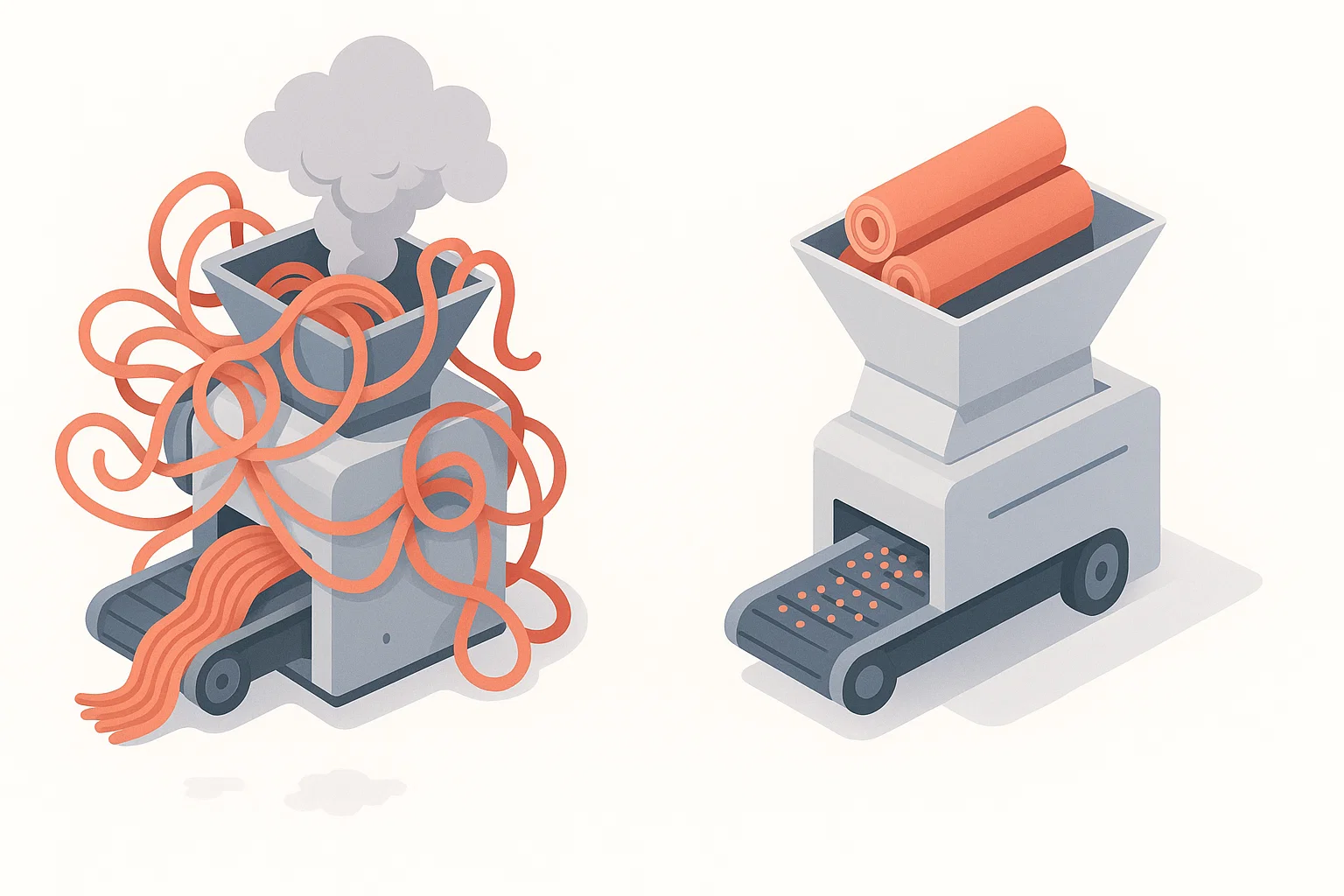Introducción: La complejidad oculta de las alfombras al final de su vida útil
En el camino hacia una economía circular, el reciclaje de residuos voluminosos presenta importantes desafíos y enormes oportunidades. Entre ellos, las alfombras al final de su vida útil representan un vasto recurso sin explotar. Cada año, millones de toneladas de alfombras se envían a vertederos en Europa y Estados Unidos, una cifra insostenible desde el punto de vista ambiental y económicamente derrochadora. Para los fabricantes y profesionales del reciclaje, convertir estos residuos en un producto valioso es un paso lógico y rentable.
Sin embargo, un error común y costoso suele frustrar estos esfuerzos desde el principio: la reducción de tamaño. Muchas empresas, equipadas con trituradoras diseñadas para materiales como metal o plástico, asumen que estas potentes máquinas pueden con todo. Pronto descubren que las alfombras son un rival excepcionalmente formidable.
Intentar procesar alfombras con una trituradora estándar no solo es ineficiente, sino que puede provocar fallos catastróficos en el equipo, costosos tiempos de inactividad y un producto de mala calidad e invendible. Este artículo explorará las razones técnicas específicas por las que las alfombras requieren un enfoque especializado y detallará por qué... trituradora textil profesional No es un lujo, sino una necesidad para cualquier operación de reciclaje seria.
La anatomía de un problema: ¿Qué hace que las alfombras sean tan difíciles de triturar?
Para entender por qué las trituradoras estándar no son adecuadas, primero debemos comprender qué es realmente una alfombra. Lejos de ser un simple textil, una alfombra moderna es un material compuesto complejo, diseñado para ofrecer durabilidad, comodidad y resiliencia. Esta misma ingeniería es la que dificulta tanto su deconstrucción.
1. Una pesadilla compuesta de materiales
Una alfombra típica consta de dos partes principales: la fibra frontal (el pelo sobre el que se camina) y el sistema de respaldo.
- Fibras faciales: Se trata de polímeros sintéticos largos, increíblemente resistentes y tenaces, como el nailon 6, el nailon 6,6, el polipropileno (PP) y el poliéster (PET), o fibras naturales como la lana. Su alta resistencia a la tracción está diseñada para resistir el desgarro y el desgaste.
- Sistemas de respaldo: El soporte es un sistema multicapa que mantiene las fibras en su lugar. Suele incluir un soporte principal (generalmente PP tejido), una capa adhesiva (comúnmente látex SBR, PVC o poliuretano) y un soporte secundario para estabilidad dimensional. Algunas losetas de moqueta comerciales utilizan betún u otros rellenos abrasivos y pesados.
Esta combinación de fibras suaves y flexibles y materiales de soporte resistentes, abrasivos y a veces pegajosos crea una pesadilla de procesamiento para una máquina que no está diseñada para manejarla.
2. El fenómeno de envoltura y obstrucción
Este es quizás el desafío más importante. A diferencia del plástico rígido o el metal frágil, que se fracturan y rompen, las fibras largas de alfombra no lo hacen. Al introducirlas en una trituradora estándar, especialmente en una con un solo eje de rotación rápida, las fibras comienzan inmediatamente a enrollarse alrededor del rotor y las herramientas de corte.
Este efecto envolvente conduce a una cascada de problemas:
- Interferencia rápida: El material envuelto se acumula, obstruyendo la cámara de corte y haciendo que la máquina se detenga bruscamente.
- Sobrecalentamiento y fusión: La fricción de las fibras envueltas genera un calor inmenso. Esto puede derretir las fibras sintéticas (como el nailon y el polipropileno), creando una masa sólida y plastificada extremadamente difícil de eliminar.
- Estrés en cojinetes y transmisión: La lucha constante contra el material envuelto ejerce una enorme presión sobre el motor, la caja de engranajes y los cojinetes, lo que provoca fallas prematuras y costosas.
3. Abrasión extrema y contaminación
Las alfombras viven en el suelo. A lo largo de su vida útil, acumulan arenilla, arena, grapas y otros contaminantes abrasivos. Esto, combinado con la naturaleza abrasiva de los soportes de látex o betún, crea un entorno altamente agresivo para las herramientas de corte. Las cuchillas de acero estándar, diseñadas para cortar plástico o fracturar metal, se desafilan a un ritmo asombroso, lo que aumenta drásticamente los costes de mantenimiento y el tiempo de inactividad.
Trituradoras estándar vs. trituradoras de alfombras: una disparidad técnica
Ahora, examinemos por qué los diseños específicos de las trituradoras de metal y plástico las hacen fundamentalmente inadecuadas para esta tarea.
Trituradores de metal: La fuerza bruta se enfrenta a un enemigo maleable
Las trituradoras de metal suelen ser máquinas de baja velocidad y alto par. Utilizan una fuerza enorme para desgarrar, cizallar y fracturar materiales rígidos y frágiles. Sus herramientas de corte son gruesas y robustas, diseñadas para soportar fuertes impactos.
- Por qué fallan las alfombras: Las alfombras no son frágiles. El alto par motor se desperdicia, ya que el material flexible simplemente se estira, se dobla y se enrolla alrededor de los ejes de movimiento lento. La trituradora no puede lograr una "mordida" limpia para iniciar un corte. En lugar de triturar, se enreda, creando el atasco descrito anteriormente.
Trituradoras y granuladoras de plástico: alta velocidad vs. alta tenacidad
Las trituradoras y granuladoras de plástico funcionan con un principio diferente. Suelen utilizar un rotor abierto de alta velocidad con cuchillas afiladas y anguladas con precisión que cortan o astillan los plásticos rígidos.
- Por qué fallan las alfombras: La alta velocidad de rotación es un desastre para los materiales fibrosos. Exacerba el efecto de envoltura casi al instante. Las cuchillas afiladas y delgadas son muy susceptibles a los daños causados por los contaminantes abrasivos de las alfombras y se desafilan rápidamente. Además, la alta velocidad genera fricción y calor, a menudo fundiendo las fibras de la alfombra en un bloque sólido, lo que puede destruir la cámara de corte.
Un diagrama de flujo de trabajo comparativo que ilustra la diferencia en el procesamiento.
| Etapa del proceso | Trituradora estándar (por ejemplo, granuladora de plástico) | Especialista en máquinas trituradoras de alfombras Energycle |
|---|---|---|
| Entrada de material | La alfombra de baja densidad “flota” sobre el rotor y resulta difícil de agarrar. | El cilindro hidráulico fuerza activamente el material hacia el rotor para lograr una alimentación positiva. |
| Acción de corte | Los cuchillos de alta velocidad enganchan fibras largas, iniciando así el enrollado. | Los cortadores de forma especial y baja velocidad cortan contra una contracuchilla, lo que evita que se enrollen. |
| Rendimiento | Atascos frecuentes y tiempos de inactividad para limpieza. El material se derrite por la fricción. | Procesamiento continuo y constante con mínima interrupción. |
| Desgaste de la cuchilla | Desgaste rápido debido al soporte abrasivo y la granalla. Requiere reemplazo frecuente. | Las hojas de acero endurecido y resistente al desgaste proporcionan una larga vida útil. |
| Producción | Inconsistente, a menudo contiene largas tiras sin cortar y grumos derretidos. | Tamaño de partícula uniforme y controlado determinado por una pantalla intercambiable. |
La solución de ingeniería: anatomía de una trituradora de alfombras especializada
Reconocer estos desafíos únicos es el primer paso. El segundo es diseñar una máquina específicamente para superarlos. En Energycle Machine, hemos invertido una importante cantidad de investigación y desarrollo en la creación de soluciones robustas para flujos de residuos problemáticos. trituradora diseñada para alfombras No es una trituradora de plástico modificada, es un equipo construido especialmente para ese fin.
Estos son los elementos de diseño clave que distinguen a una trituradora de alfombras profesional:
- Diseño de rotor antienrollamiento especializado: Este es el corazón de la máquina. En lugar de un simple rotor cilíndrico, nuestras trituradoras de alfombras cuentan con un rotor segmentado o con un perfil especial. Las cuchillas están dispuestas en un patrón específico que evita activamente que las fibras largas se enrollen alrededor del eje, garantizando un corte continuo.
- Tecnología avanzada de corte y cuchilla: Utilizamos cortadores cóncavos de forma única, fabricados con aleaciones patentadas de acero endurecido. Estos cortadores ofrecen una acción de corte y desgarro en lugar de una cizalladura de alta velocidad. Este diseño robusto es mucho más resistente a la abrasión del soporte de la alfombra y a la suciedad incrustada, lo que prolonga considerablemente la vida útil de la cuchilla y reduce los costos operativos.
- Empujador hidráulico inteligente (ariete): Las alfombras son voluminosas, pero no densas. Un sistema de alimentación por gravedad es ineficiente. Nuestras trituradoras incorporan un cilindro hidráulico con sensor de carga que empuja con fuerza e inteligencia la alfombra hacia el rotor. Esto garantiza una presión de alimentación constante y positiva, evitando que el material se mueva sobre el rotor y maximizando el rendimiento.
- Clasificación de pantalla para una salida precisa: Un reciclaje eficaz requiere una materia prima consistente y homogénea para el siguiente proceso (por ejemplo, pirólisis, extrusión o recuperación de fibras). Nuestras trituradoras de alfombras están equipadas con pantallas intercambiables de alta resistencia debajo de la cámara de corte. El material triturado se retiene hasta que alcanza un tamaño lo suficientemente pequeño como para pasar por los orificios de la pantalla, lo que garantiza un tamaño de partícula uniforme, adaptado a sus necesidades específicas. Entendiendo su diseño único es clave para apreciar su eficiencia.
- Transmisión robusta con protección contra sobrecargas: El sistema de transmisión de potencia está diseñado para generar un alto par a bajas velocidades, lo que proporciona la potencia necesaria para atravesar densos grumos de soporte y fibra sin calarse. Los avanzados sistemas electrónicos y mecánicos de protección contra sobrecargas protegen toda la transmisión contra daños en caso de que se introduzca accidentalmente un objeto no triturable (como un trozo grande de metal).
Al integrar estas características, una trituradora de un solo eje Energycle Machine transforma la compleja tarea de triturar alfombras en un proceso industrial eficiente, rentable y sin complicaciones. Le invitamos a... ver esta trituradora de alfombras para ver estos principios en acción.
El retorno de la inversión (ROI) de la especialización: por qué la máquina adecuada se amortiza sola
Invertir en una trituradora de alfombras especializada de Energycle Machine no es un gasto; es una inversión en productividad y rentabilidad.
- Tiempo de actividad y rendimiento maximizados: Reduzca drásticamente el tiempo de inactividad asociado con la eliminación de atascos y la limpieza de plástico derretido, lo que genera mayores volúmenes de procesamiento.
- Resultados consistentes y de alto valor: Producir un material reciclado uniforme, limpio y vendible, que alcance un precio más alto en el mercado de materias primas.
- Costos de mantenimiento drásticamente reducidos: Benefíciese de una vida útil de la cuchilla significativamente más larga y un menor desgaste de los componentes principales, como motores y cojinetes.
- Seguridad operativa mejorada: Una máquina que funciona dentro de sus parámetros de diseño es más segura. Elimine los riesgos asociados con atascos catastróficos y sobrecargas de motores.
Al elegir la herramienta adecuada para el trabajo, convierte una responsabilidad (desperdicios de alfombras voluminosos) en una fuente de ingresos constante y valiosa.
Preguntas frecuentes (FAQ)
1. ¿Una trituradora de alfombras especializada de Energycle Machine también puede procesar otros textiles?
Por supuesto. Nuestras trituradoras textiles son muy versátiles. Si bien están diseñadas específicamente para la dureza de las alfombras, también son excepcionalmente eficaces para procesar otros materiales fibrosos como ropa, tapicería, colchones y textiles industriales como hilos y mechas.
2. ¿Qué determina el tamaño final del material de alfombra triturado?
El tamaño de salida se controla con precisión mediante la malla perforada instalada en la máquina. Energycle Machine ofrece una amplia gama de tamaños de malla, generalmente de 20 mm a 100 mm, lo que le permite producir el tamaño de partícula exacto requerido para sus procesos posteriores. Podemos asesorarle sobre el tamaño óptimo para su aplicación específica.
3. ¿Cómo manejan sus trituradoras contaminantes como grapas metálicas o clavos en la alfombra?
Nuestras trituradoras están diseñadas para ser robustas. Su diseño de alto par y baja velocidad, combinado con cuchillas de acero endurecido, permite cortar fácilmente pequeños contaminantes como grapas. Para piezas metálicas más grandes, nuestro avanzado sistema de detección de sobrecarga detiene o invierte automáticamente el rotor para evitar daños y proteger su inversión.
4. ¿Cuál es el programa de mantenimiento típico para una trituradora de alfombras especializada?
El mantenimiento es sencillo y consiste principalmente en la rotación y sustitución regular de las cuchillas, así como en revisiones periódicas de los sistemas hidráulico y de accionamiento. Gracias a sus materiales resistentes al desgaste y a su diseño robusto, los intervalos de mantenimiento de una trituradora Energycle Machine son significativamente más largos que los de una máquina estándar utilizada para esta aplicación, lo que garantiza un tiempo de funcionamiento máximo.
Conclusión: tome la decisión correcta para su operación
El mensaje es claro: la alfombra no es un simple residuo. Su singular estructura compuesta exige más que fuerza bruta o alta velocidad; requiere una solución de ingeniería. Intentar usar una trituradora estándar de metal o plástico es una receta para la frustración, las pérdidas económicas y el fracaso.
Una trituradora de alfombras especializada y diseñada específicamente para este fin es la única manera de aprovechar de forma fiable y rentable el valor que esconde este complejo flujo de residuos. Al invertir en una máquina diseñada teniendo en cuenta los retos específicos de las alfombras, desde rotores antienrollamiento hasta sistemas de alimentación inteligentes, usted prepara su operación para el éxito.
¿Está listo para convertir su problema de desperdicio de alfombras en una oportunidad rentable?
El equipo de expertos de Energycle Machine está aquí para ayudarle a seleccionar la solución de trituración perfecta para sus necesidades específicas. Analizamos sus materiales, requisitos de rendimiento y objetivos operativos para recomendarle una máquina que ofrezca un rendimiento y una fiabilidad inigualables.
Contáctenos hoy para una consulta sin compromiso o para solicitar un presupuesto detallado. Construyamos juntos un futuro más rentable y sostenible.



